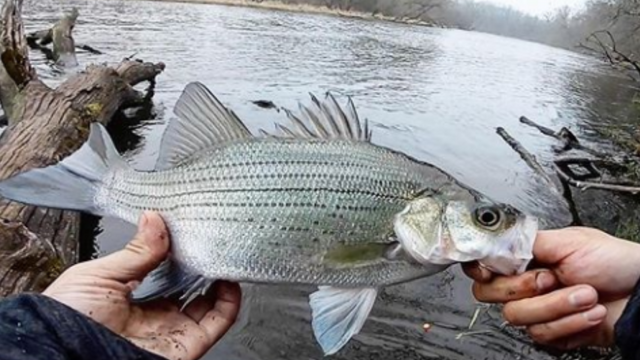
White Bass Or Sand Bass? The Highly Underrated All American Fish
Is it white bass or sand bass? Personally, I call the fish “white lighting” because they strike with a vicious jolt and then bolt for deep water to pull free from my lure’s hooks. Many Southern anglers refer to them as sand bass but pretty much everywhere else they're know as white bass.
White bass are a silvery, spiny-rayed fish similar to a striped bass but smaller than a striper. White bass are in the South and Midwest but have been distributed in rivers and lakes throughout the United States.
Native ranges of the white bass are the Arkansas River, western Lake Erie, the Detroit River, and Lake Poinsett in South Dakota. Native fish are also abundant in the Winnebago lakes system of Wisconsin and in Oklahoma.
What Are White Bass?
Credit: Dyangbass
White bass are schooling fish, which appear in large numbers where food is abundant and move on when the food supply is exhausted. The fish feed mainly in the early morning and late evening near the surface where forage fish such as shad tend to congregate. Whereas black bass and crappie tend to relate to cover to ambush prey, white bass roam the open water and rely on their speed to track down prey.
The White Bass Run
Credit: Dyangbass
Spring is a prime time to catch white bass when the fish make spawning runs to the shoals of creeks and rivers. Some white bass in lakes will also spawn along windswept shorelines. The optimal water temperature for the white bass spawning season is between 54 degrees to 68 degrees. Unlike black bass and crappie that lay eggs in nests and fan the eggs to keep them clean, white bass lay eggs on gravel and rocks in moving water and rely on the water flow to keep their eggs clean.
On my home waters of Lake of the Ozarks I find spawning white bass in the tributaries and creeks flowing into the lake. The whites usually congregate around the first or second set of riffles in the creeks off the main lake. I can either catch these spawning fish in the riffles or the deeper holes above and below the riffles. A variety of spinners, small swimbaits, jigs and spoons will trigger strikes from spawning whites but my favorite lures for tricking these fish are a 2-inch fire tiger Rapala floating stickbait or a 4-inch floating Rapala stickbait trailed by a 1/16-ounce pink marabou jig attached to a 6-inch leader line. I steadily jerk the 2-inch Rapala to tempt the whites and employ a jerk-and-pause retrieve for the Rapala and jig combo.
White bass make a quick exit from the creeks after laying and fertilizing their eggs. The fish head for the deeper open waters of a lake or river where they reside throughout the summer. Some of their summer haunts include offshore humps, points and channel bends on reservoirs and deep holes or eddies behind wing dikes or other current breaks on rivers.
Tackle For Targeting White Bass
Credit: Dyangbass
Jump fishing is a popular way to catch white bass in the open waters from late spring to early fall. This tactic requires keeping on the lookout for huge explosions of white bass busting baitfish on the surface then moving quickly but quietly to the surface activity before the fish drop down into the deep. You can catch these fish on a multitude of shad-imitating lures as long as you use one heavy enough to cast a long distance. White bass tend to spook if your boat gets too close to the feeding activity so you need to make long deliveries with spoons or topwater plugs such as Whopper Ploppers, chuggers or mid-size walking baits. If the fish ignore the topwater plugs, I throw a 1/8-ounce jigging spoon to the busting fish and skip it across the surface to draw strikes. The spoon is about the same size as the baitfish the whites are feeding on and it is heavy enough to cast a long distance yet light enough to keep it skipping along the surface with a fast retrieve.
Where To Find White Bass
Credit: Dyangbass
White bass will also follow shad into the backs of creeks and coves on lakes in the fall where you can catch these fish on the same topwater plugs used for jump fishing and spinners, lipless crankbaits, and small swimbaits attached to Alabama rigs. Look for the same surface explosions you see on the main lake to target the whites in the backs of the creeks. You can also troll small crankbaits and lipless crankbaits through the pods of baitfish to catch whites hanging below the forage fish.
During late fall, the baitfish and white bass move out to the secondary and main lake points as the water temperatures continue to drop. Prime spots for finding marauding whites during this time are windblown rocky points. I throw a 4-inch floating stickbait close to the bank and jerk it steadily to catch white bass trapping shad against the shallow rocks. When the fish move away from the bank, I throw across the point with an Alabama rig adorned with small swimbaits to catch whites in the mid-depth range.
When fishing for white lightning, hold tight to your rod because these fish strike hard enough to knock the rod right out of your hands.
Updated October 14th, 2020 at 7:28 AM CT
